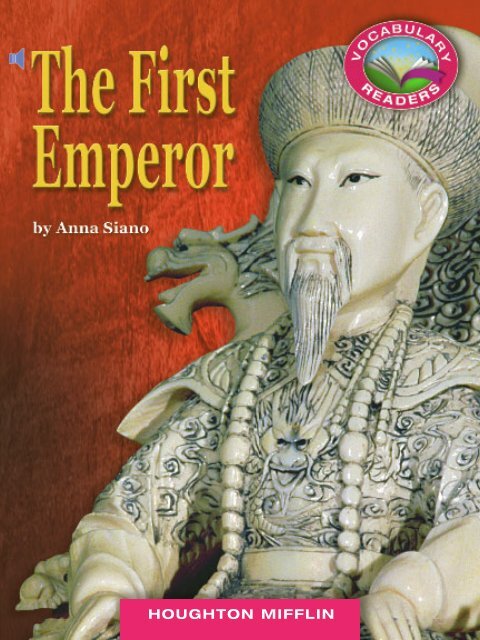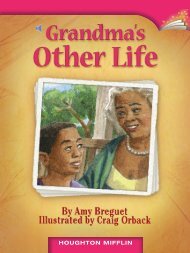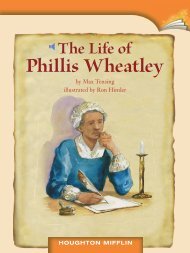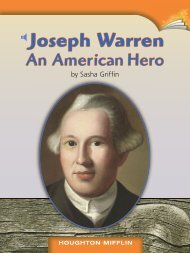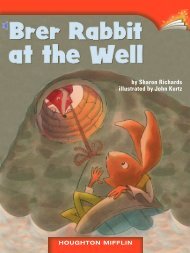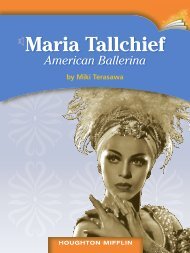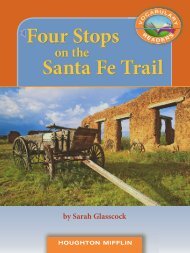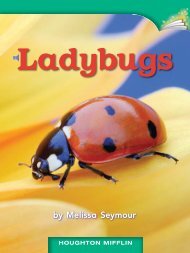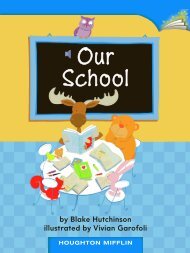Create successful ePaper yourself
Turn your PDF publications into a flip-book with our unique Google optimized e-Paper software.
HOUGHTON MIFFLIN
y Ann Siano<br />
ILLUSTRATION CREDITS: 4 Joe LeMonnier / Melissa Turk; 5, 10 Ron Himler c /o Kirchoff/Wohlberg<br />
PHOTOGRAPHY CREDITS: Cover © Private Collection / <strong>The</strong> Bridgeman Art Library; 1 Getty; 2 © dk / Alamy; 3 © Private<br />
Collection / <strong>The</strong> Bridgeman Art Library; 6–7 © Getty; 9 © Gavin Hellier / Alamy; 11 © Keren Su / China Span / Alamy;<br />
12–13 © Keren Su/China Span / Alamy; 14 © Jose Fuste Raga / Corbis; 9, 11 (bkgrnd) PhotoDisc / Background Series;<br />
Bkgrnd PhotoDisc / Background Series<br />
Copyright © by Houghton Mifflin Harcourt Publishing Company<br />
All rights reserved. No part of this work may be reproduced or transmitted in any form or by any means, electronic or<br />
mechanical, including photocopying or recording, or by any information storage and retrieval system, without the prior<br />
written permission of the copyright owner unless such copying is expressly permitted by federal copyright law. Requests<br />
for permission to make copies of any part of the work should be addressed to Houghton Mifflin Harcourt School Publishers,<br />
Attn: Permissions, 6277 Sea Harbor Drive, Orlando, Florida 32887-6777.<br />
Printed in China<br />
ISBN-13: 978-0-547-02909-2<br />
ISBN-10: 0-547-02909-8<br />
1 2 3 4 5 6 7 8 0940 18 <strong>17</strong> 16 15 14 13 12 11<br />
If you have received these materials as examination copies free of charge, Houghton Mifflin Harcourt School Publishers<br />
retains title to the materials and they may not be resold. Resale of examination copies is strictly prohibited.<br />
Possession of this publication in print format does not entitle users to convert this publication, or any portion of it, into<br />
electronic format.
A Boy King<br />
Over two thousand years ago, there were seven<br />
distinct kingdoms that made up ancient China. <strong>The</strong>se<br />
kingdoms fought constantly with each other.<br />
In 246 b.c.e., a young boy became the king of<br />
Qin (chin), the strongest kingdom. He was only<br />
thirteen years old, but already he had big plans. He<br />
not only wanted to rule his country, but all the others<br />
around him as well. So, he set out to conquer the world!<br />
He led a fierce army into battle after battle. His<br />
soldiers numbered in the hundreds of thousands. Most<br />
belonged to the infantry. <strong>The</strong>se foot soldiers looked<br />
like waves of the ocean when they marched onto the<br />
field. <strong>The</strong> cavalry officers on small, sturdy horses rode<br />
beside them.<br />
Some of the<br />
soldiers wore<br />
armor made of small,<br />
linked squares of iron<br />
or leather. Most dressed in<br />
simple tunics. <strong>The</strong>y all carried<br />
weapons.<br />
<strong>The</strong> Chinese were the first<br />
to invent the crossbow.<br />
2
Infantry with crossbows would<br />
precede the other soldiers. <strong>The</strong>ir short<br />
heavy arrows caused panic among the<br />
enemy. <strong>The</strong>n the rest of the infantry<br />
charged. <strong>The</strong>se soldiers fought handto-hand<br />
combat with bronze swords<br />
or halberds. <strong>The</strong>se were sharp<br />
blades on poles. Meanwhile,<br />
the cavalry raced all over<br />
the battlefield, attacking<br />
wherever possible.<br />
<strong>The</strong> king of Qin<br />
would become<br />
China’s first emperor.<br />
3
A United Kingdom<br />
By 221 b.c.e., the king was the ruler of all of<br />
China. It had taken him over twenty years, but he had<br />
done it! His work was not finished yet, however. China<br />
was big. Mountains, deserts, river valleys, and plains<br />
separated parts of it from each other.<br />
How could he unify his empire? How would he keep<br />
order? <strong>The</strong>se were the challenges facing Qin Shihuang<br />
(chin shir hwong), the first emperor of China.<br />
4
Farmers worked from dawn to dusk. <strong>The</strong>y pedaled a machine<br />
to move water uphill to their fields.<br />
Building China’s Foundations<br />
For many years before Qin Shihuang rose to<br />
power, a feudal (FYOOD uhl) system had been in<br />
place. Under feudalism, nobles owned great tracts of<br />
land. Peasants farmed it for them. Nobles were loyal<br />
to their king. Peasants were loyal to the nobles.<br />
Qin Shihuang wanted the Chinese people to be<br />
loyal only to him. So, he forced the nobles to move to<br />
the capital city. <strong>The</strong>y were not pleased about this at all!<br />
<strong>The</strong> peasants remained on the land.<br />
5
<strong>The</strong>y farmed as before. Instead of paying their<br />
taxes to the local lords, however, they paid them to the<br />
emperor’s officials.<br />
<strong>The</strong>n Qin Shihuang divided China into districts. He<br />
chose a governor to supervise each one. <strong>The</strong> governors<br />
reported back to him. This gave him total control.<br />
Just to make sure that no one thought about<br />
rebelling, Qin Shihuang also collected all of the<br />
weapons. Only his soldiers could keep theirs.<br />
According to one account, he had the rest melted<br />
down to form huge bells and statues.<br />
But, remember, these were the days long before<br />
cell phones and the Internet! Qin Shihuang had to<br />
figure out how to keep in touch with all parts of his<br />
huge empire. He also needed to move goods and<br />
soldiers around. He decided to build a network of<br />
roads. Of course, he did not do any of the labor.<br />
<strong>The</strong> Great Wall<br />
of China<br />
6
Peasants did it for him. Thousands upon thousands<br />
of men had to leave their farms and travel miles away<br />
to work for the emperor. Many never returned home.<br />
A Complex Man<br />
Qin Shihuang’s character was full of<br />
contradictions. He had been a brave military leader.<br />
Yet now, as a powerful emperor, he had many fears. He<br />
worried that if people learned new ideas, they would<br />
revolt. To stop this from happening, he destroyed<br />
entire libraries of books. He also killed hundreds of<br />
scholars because they criticized the way he ruled. Soon,<br />
no one dared speak out against the emperor.<br />
Qin Shihuang was also afraid of invaders. He built<br />
a great wall to protect the northern border. Several<br />
short walls already existed. He had workers join them<br />
together. <strong>The</strong>y also added watchtowers.<br />
7
This great wall took thousands of men many years<br />
to construct. In some places, they had to make the<br />
wall out of gravel, water, and twigs. Other parts were<br />
carved out of rock or made of packed earth. Laborers<br />
suffered through bitter cold winters and worked under<br />
terrible conditions. Because so many died and are<br />
buried next to the Great Wall, it is sometimes called<br />
“the longest graveyard in the world.”<br />
An <strong>Emperor</strong>’s Fears<br />
Qin Shihuang’s greatest fear was death. He sent<br />
groups to look for mythical potions that might help<br />
him live forever. Of course, these did not exist. He<br />
also forced workers to build him an elaborate tomb.<br />
This tomb looked like a royal city, only underground.<br />
It covered over 20 square miles. It was stocked with<br />
everything the emperor might need in the afterlife. It<br />
even held clay replicas of his soldiers. Remarkably, it<br />
remained hidden until 1974.<br />
When Qin Shihuang died in 210 b.c.e., some of<br />
his other fears came true, too. <strong>The</strong> empire fell apart.<br />
Civil war broke out. This ended only when another<br />
strong leader, Liu Bang (loo bawng), defeated his<br />
opponents. His reign began the Han Dynasty.<br />
8
Ancient China<br />
475 B.C.E.<br />
Seven states fight<br />
to rule China.<br />
206 B.C.E.<br />
<strong>The</strong> Han Dynasty begins.<br />
551 B.C.E.<br />
Confucius is born.<br />
221 B.C.E.<br />
Qin Shihuang unifies China.<br />
Some great leaders have cruel temperaments.<br />
Qin Shihuang was one such leader. His methods may<br />
have been harsh, but they unified China. Before Qin<br />
Shihuang, people thought of themselves as belonging<br />
to the state of Qin or Wei (way) or Chu. Afterwards,<br />
they thought of themselves as Chinese. This is part of<br />
the legacy he left to later dynasties.<br />
A New Era Begins<br />
<strong>The</strong> first emperor of the Han Dynasty, Liu Bang,<br />
was not born a king. He was a peasant. He was not well<br />
educated or very dignified. He used rude language.<br />
9
He didn’t sit on his throne when he met with advisors.<br />
Instead, he crouched on the floor, peasant-style. But,<br />
Liu Bang was smart. He knew that Qin Shihuang’s<br />
strong central government was good for China.<br />
In fact, he and later Han emperors improved the<br />
government by creating a civil service. Under this<br />
system, men who wanted an official job had to take<br />
tests. Those who did the best were hired.<br />
<strong>The</strong> Han leaders also tried to follow the teachings<br />
of Confucius (kuhn FYOO shuhs). Centuries before,<br />
this philosopher had advised rulers to act like fathers<br />
to their subjects. As a result, the lives of the common<br />
people under the Han emperors improved somewhat.<br />
Only the most qualified<br />
candidates passed the<br />
civil service test.<br />
10
Confucius<br />
<strong>The</strong> most influential philosopher in Chinese history<br />
was born over 2,500 years ago. Confucius worked in<br />
government positions throughout his life. But, he<br />
attracted followers because of his teachings.<br />
One of his strongest beliefs was in the<br />
value of education. He felt that learning<br />
about classical subjects helped build<br />
people’s character.<br />
He also thought that certain rules<br />
of behavior should be followed in<br />
relationships. For example, children<br />
should respect their fathers. Fathers<br />
should act wisely on behalf<br />
of their children. <strong>The</strong>se<br />
ideas applied to rulers<br />
and subjects as well.<br />
Confucius believed<br />
that proper relationships<br />
formed the basis<br />
of order in society.<br />
Confucius is known as<br />
one of the greatest<br />
teachers who ever lived.<br />
11
Opening Up to the Outside World<br />
Unlike Qin Shihuang, the Han emperors did<br />
not fear the outside world. <strong>The</strong>y began to trade<br />
with other countries. <strong>The</strong> Chinese held the secret of<br />
making lustrous, shimmering silk. <strong>The</strong>y wove it from<br />
the cocoons of silkworms. Many people wanted this<br />
material, no matter how much it cost! Huge bolts<br />
of silk were shipped to Indians, Romans, Arabs, and<br />
others. In return, the Chinese received gold, silver,<br />
and wool.<br />
Merchants and camels laden with goods traveled<br />
to and from China by way of the Silk Roads. <strong>The</strong>se<br />
were rough roads or paths that stretched for over<br />
4,000 miles. <strong>The</strong>y wound through deserts and over<br />
mountains from China to the Mediterranean region.<br />
<strong>The</strong> Silk Roads also brought the Chinese into<br />
contact with the ideas of other people. <strong>The</strong>ir years of<br />
isolation were over. One result was that the Buddhist<br />
religion spread from India to China. It became an<br />
important part of Chinese culture.<br />
Silk Road, Xinjiang Province<br />
13
About 8,000 terra cotta soldiers guard<br />
the tomb of Qin Shihuang.<br />
Part of History<br />
Throughout time, the Chinese kept accurate<br />
records of what happened and what they did. <strong>The</strong><br />
work of archaeologists also provides us with a great<br />
deal of information about China. <strong>The</strong>y continue to<br />
excavate sites that have been discovered in recent<br />
decades. From the items they dig up, we can see how<br />
the ancient Chinese lived and what they valued.<br />
So why is it important to learn about people from<br />
long ago? Knowing about the past can help us to<br />
understand the present. <strong>The</strong> past is an earlier chapter<br />
of an ongoing history of the world. And it is not<br />
finished yet! We still have our own chapters to write.<br />
14
Responding<br />
TARGET VOCABULARY Word Builder Make<br />
a word web around the word elaborate. What<br />
words do you know that have the same meaning?<br />
Copy the diagram and add more words.<br />
decorate ?<br />
elaborate<br />
? ?<br />
Write About It<br />
Text to Self Write a paragraph explaining how<br />
the emperor’s lifestyle was different from the<br />
lives of his subjects. Include two words from the<br />
Word Builder in your explanation.<br />
15
TARGET VOCABULARY<br />
archaeologists<br />
dignified<br />
distinct<br />
elaborate<br />
excavate<br />
lustrous<br />
mythical<br />
precede<br />
replicas<br />
temperaments<br />
TARGET STRATEGY Question Ask questions<br />
about a selection before you read, as you read, and<br />
after you read.<br />
A unicorn is an example of a<br />
________ creature.<br />
16
Level: W<br />
DRA: 60<br />
Social Studies<br />
Strategy:<br />
Question<br />
Word Count: 1,619<br />
6.4.<strong>17</strong> Build Vocabulary<br />
HOUGHTON MIFFLIN<br />
Online Leveled Books<br />
1033044


